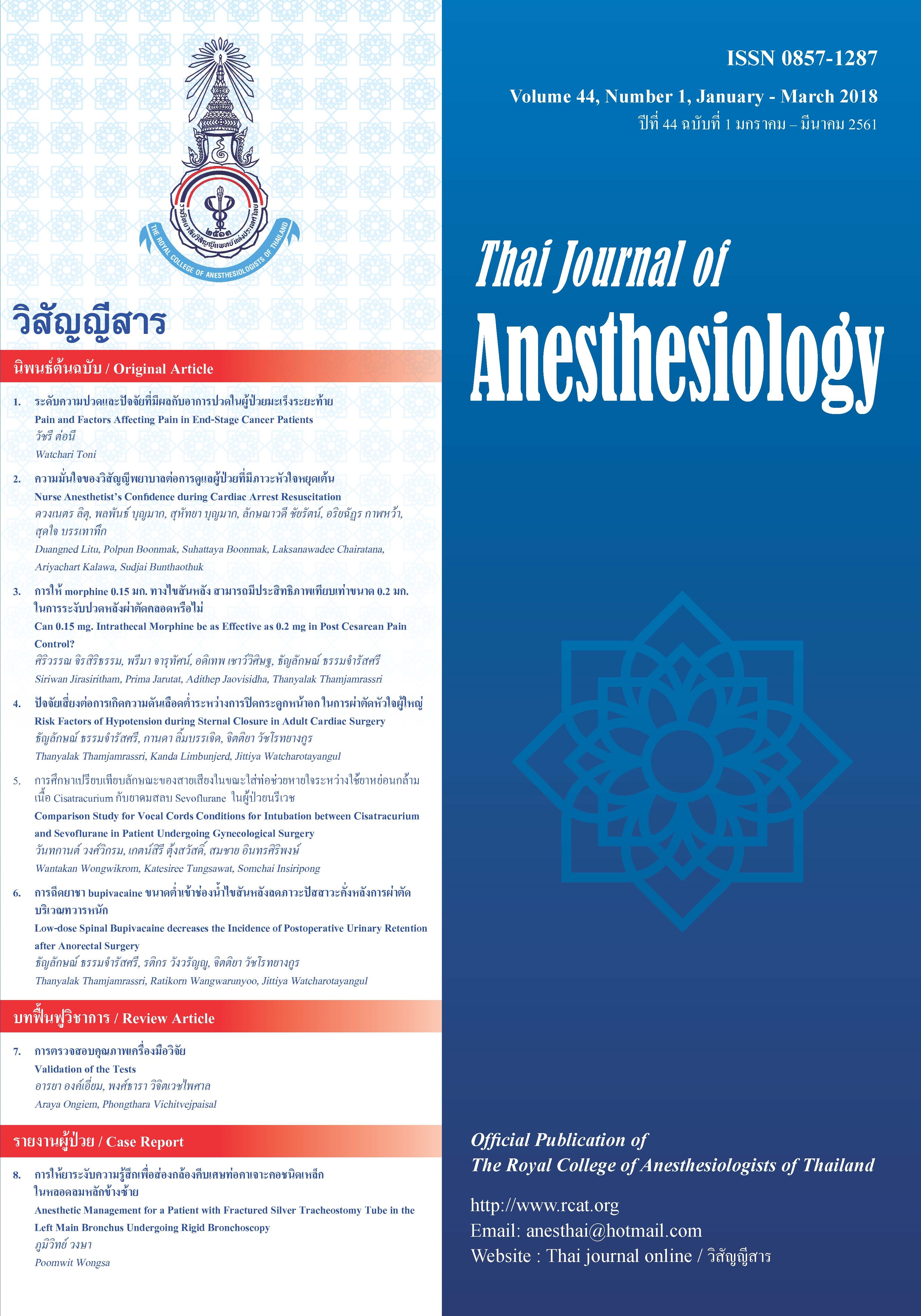Low-dose Spinal Bupivacaine decreases the Incidence of Postoperative Urinary Retention after Anorectal Surgery
Main Article Content
Abstract
Background: Postoperative urinary retention is the most
common complication after anorectal surgery. A significant
risk factor for this complication is spinal anesthesia.
Objective: To compare postoperative urinary retention
after anorectal surgery under spinal anesthesia between
3 mg and 6 mg of 0.5% hyperbaric bupivacaine.
Methods: This study was approved by the Ramathibodi
Ethics Committee. Eighty patients undergoing surgical
treatment for hemorrhoids, anal fissures, anal fistulas,
or perianal abscesses were enrolled in this prospective
controlled trial and randomized into two groups: the
low-dose and conventional-dose groups. The patients
in the low-dose and conventional-dose groups received
spinal anesthesia with 3 mg and 6 mg of 0.5% hyperbaric
bupivacaine, respectively, and then sat for at least
5 minutes before positioning for the operation. During the
operation, patients were sedated with midazolam and/or
fentanyl if necessary. The primary outcome was incidence
of postoperative urinary retention.
Results: Data of all 80 patients were analyzed. Low-dose
spinal bupivacaine lowered the risk of urinary retention
from 32.5% to 7.5% (P = 0.005) (relative risk = 0.231, 95%
confidence interval = 0.071-0.748). The postoperative
morphine consumption during the first 24 hours
postoperatively were not significantly different between
the groups. Conclusions: Spinal anesthesia with 3 mg of 0.5%
hyperbaric bupivacaine provides adequate anesthesia
for surgery with a lower incidence of postoperative urinary
retention.
Article Details
References
JG. Symptomatic hemorrhoids: current incidence and
complications of operative therapy. Dis Colon Rectum
1992;35(5):477-81.
2. Ogilvie JW, Ricciardi R. Complications of perineal surgery.
Clin Colon Rectal Surg 2009; 22(1): 51-9.
3. Toyonaga T, Matsushima M, Sogawa N, et al. Postoperative
urinary retention after surgery for benign anorectal disease:
potential risk factors and strategy for prevention. Int J
Colorectal Dis 2006;21(7):676-82.
4. Baldini G, Bagry H, Aprikian A, Carli F. Postoperative urinary
retention anesthetic and perioperative considerations.
Anesthesiology 2009;110(5):1139-57.
5. Zaheer S, Reilly WT, Pemberton JH, Ilstrup D. Urinary
retention after operations for benign anorectal diseases. Dis
Colon Rectum 1998;41(6):696-704.
Barone JG, Cummings KB. Etiology of acute urinary retention
following benign anorectal surgery. Am Surg 1994;60:210-1.
7. Kamphuis ET, Ionescu TI, Kuipers PW, de Gier J, van Venrooij
GE, Boon TA. Recovery of storage and emptying functions
of the urinary bladder after spinal anesthesia with lidocaine
and bupivacaine in men. Anesthesiology 1998;88(2):310-6.
8. Gudaityte J, Mrchertiene I, Karbonskiene A, et al. Low-dose
spinal hyperbaric bupivacaine for adult anorectal surgery:
a double-blinded, randomized, controlled study. J Clin
Anesth 2009;21(7):474-81.
9. Wassef MR, Michaels EI, Rangel JM, Tsyrlin AT. Spinal
perianal block: a prospective, randomized, double-blind
comparison with spinal saddle block. AnesthAnalg 2007;
104(6):1594-6.
10. Geller EJ. Prevention and management of postoperative
urinary retention after urogynecologic surgery. Int J Womens
Health 2014;6:829-38.
11. Kwang Suk Lee, Kyo Chul Koo, and Byung Ha Chung. Risk
and management of postoperative urinary retention following
spinal surgery. Int Neurourol J 2017;21(4): 320-8.


